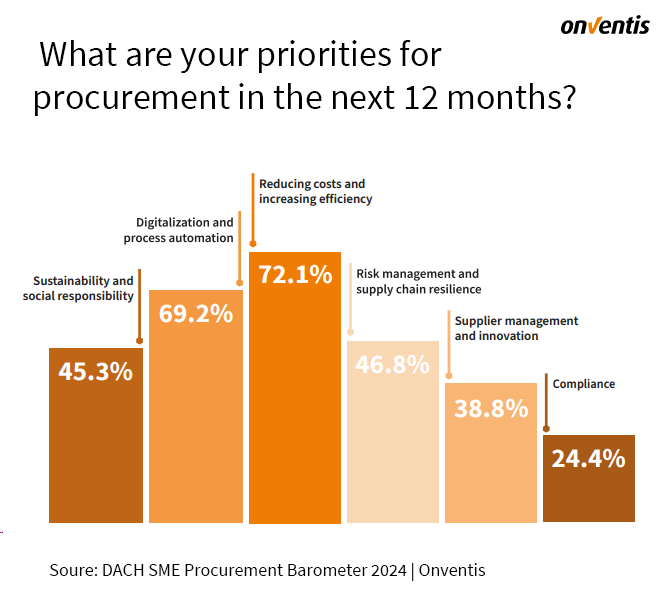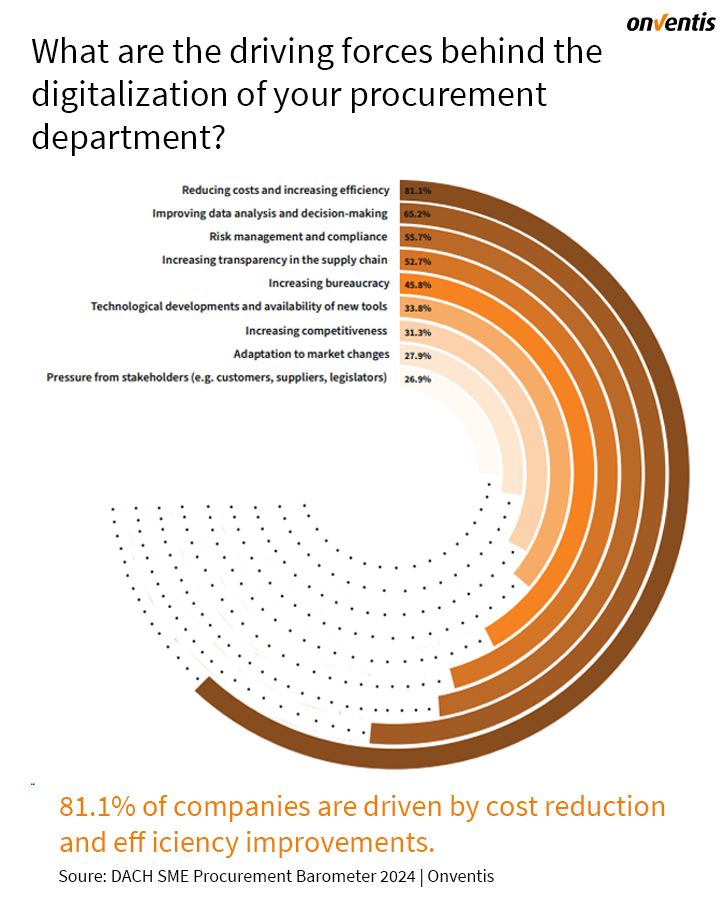Procurement optimization: Future-Proofing Purchasing
Procurement is the engine that ensures production and operations are consistently supplied with the necessary goods. With procurement as the engine to ensure production and operations are consistently supplied with the necessary good, effective and efficient procurement is the key to a company’s success. Without it, everything would come to a standstill.

Procurement optimization: Future-Proofing Purchasing
Procurement is the engine that ensures production and operations are consistently supplied with the necessary goods. With procurement as the engine to ensure production and operations are consistently supplied with the necessary good, effective and efficient procurement is the key to a company’s success. Without it, everything would come to a standstill.
In light of rapid digitalization needs, procurement is currently undergoing a revolution: manual methods are outdated, while digital processes accelerate workflows, reduce errors through automation, and bring more transparency to procurement processes. This transparency allows companies to make informed decisions and respond more quickly to market changes.
Strategies for procurement optimization are not just a response to current challenges but also a crucial step toward a future-oriented way of working. In this blog, we explain these strategies to show you how to optimize your procurement processes and succeed on your path to digital transformation.
The Need for Optimization
According to mid-sized procurement teams, the key to resilient and future-proof purchasing lies in the optimization of order processing and process automation. In our annual study, conducted in collaboration with the BME and the ESB Business School, we collect information to provide an up-to-date picture of procurement digitalization in companies in the DACH region. The goal is to understand the current and future digitalization agenda and their alignment with current trends and regulations.
An interesting result emerged when asked about the measures procurement plans to implement within the next year. Respondents indicated that cost reduction measures are at the forefront of all plans, ranking highest on the priority list for mid-sized companies and SMEs. Additionally, it became clear that mid-sized companies are driving digitalization primarily to reduce process costs and integrate automation into their procurement processes.


Study: From E-Invoicing to the Green Supply Chain
The 6th edition of the study explores the tension between digitalization activities and the current priorities of purchasing teams in the DACH region.
It provides an up-to-date picture of procurement agendas in medium-sized companies, analyses the tools used, highlights weaknesses, and identifies potential for optimizing procurement.
But how can you do this? We have some practical tips to help you take your procurement processes to the next level and achieve your digitalization goals:
- Centralize your procurement: By centralizing procurement, companies can benefit from economies of scale. Procuring large quantities of goods or services allows for better price negotiation and reduces administrative effort. This strategy can also lead to better standardization and more efficient supplier management.
- Use of Just-in-Time (JIT) procurement: JIT is a strategy where materials or goods are delivered exactly at the time of production or use. This helps reduce inventory costs and optimize material flow. Companies using JIT can reduce storage space requirements, save costs, and minimize the risk of overstock. However, this requires intensive data exchange between the buyer and supplier, based on smooth communication between all parties.
- Build strategic supplier relationships: Long-term partnerships with suppliers offer advantages such as higher supply quality and more stable prices. These relationships allow companies to develop a better understanding of the supply chain, positively impacting supply chain security. Companies can also develop innovative solutions in collaboration with suppliers. Especially with the JIT concept, secure and strategic supplier relationships are essential to maximize material flow optimization.
- Data analytics: The use of data analytics allows companies to make informed decisions. By analyzing procurement patterns, process weaknesses can be identified, and optimization potentials recognized. This leads to improved processes, cost reduction, and higher efficiency.
- Training and involvement of employees: The role of employees in procurement is crucial. Regular training ensures that staff are informed about current best practices while involving employees in the optimization process can increase their motivation and acceptance of changes. Good communication between teams ensures everyone is on the same page and can work together effectively. Additionally, this ensures they are always informed about current purchasing guidelines, preventing Maverick Buying (purchasing goods and services outside or parallel to the established procurement process). The result: cost savings and reduction of compliance violations!
Digitalizing Procurement Processes: Save Time, Money, and Stress with Automation
Streamline operations and reduce costs. Manual procurement processes are time-consuming, error-prone, and costly. By automating procurement processes, companies can save time and money, and reduce…
Technologies and Their Role in Procurement Optimization
IMPLEMENTATION OF E-PROCUREMENT SYSTEMS
Perhaps the most important component of optimized procurement is digitalization. More specifically, it involves the implementation of e-procurement systems that automate and digitalize the procurement process from demand identification, supplier management, ordering, payment, to expenditure analysis. This bundling and automation of individual phases not only increases transparency but also enhances efficiency, reduces costs, and ensures compliance in one go.
Modern technologies such as artificial intelligence and machine learning play an increasingly important role in automating and improving procurement processes. They enable efficient analysis of large data volumes, forecasting, and optimizing supplier management.
The previously mentioned strategies for procurement optimization are often only possible with e-procurement. Effective supplier relationship management, digital ordering processes, automated invoice processing, and the central analysis of all procurement data are best housed in a digital system.
CHALLENGES AND SOLUTION APPROACHES
Despite the benefits that digitalization and other optimization strategies offer, companies often face challenges such as resistance within the organization or technical difficulties. A gradual implementation of changes, change management, and strong leadership are crucial for success.
The process of selecting suitable software often proves to be complex and lengthy, as a multitude of providers shape the market. We have compiled a blog to make the search and selection as easy as possible for you and to ensure that you and your company are best prepared for the introduction of digitalization.
Software for Procurement: Our Guide to Your Right S2P Solution
Companies that want to succeed in today’s environment must maintain control of their entire procurement cycle, from demand identification to invoice payment. Choosing the right software for procurement can significantly impact the efficiency and success of your procurement operations. That’s where…
Procurement Optimization as a Key to Future-Proof Purchasing Strategy
In light of advancing digitalization, companies should rethink and optimize their procurement processes. Manual processes are a thing of the past; automated and digitalized workflows are the new standard.
Our blog has shown you which strategies can help you make your procurement more efficient, cost-effective, and resilient. From centralizing procurement to utilizing just-in-time strategies, building strategic supplier relationships and integrating data analytics – we provide you with the tools to take your procurement to a new level.
Remember, while digitalization and process optimization offer enormous advantages, they can also present challenges. Success often depends on gradual implementation and strong leadership that promotes change within the organization.
Start today by digitalizing, optimizing, and future-proofing your procurement processes. Our procurement experts are ready to support you in your digital transformation. Schedule a live demo with us or follow our LinkedIn profile to stay informed about current procurement topics!
Weitere BlogsMore BlogsMeer blogs




